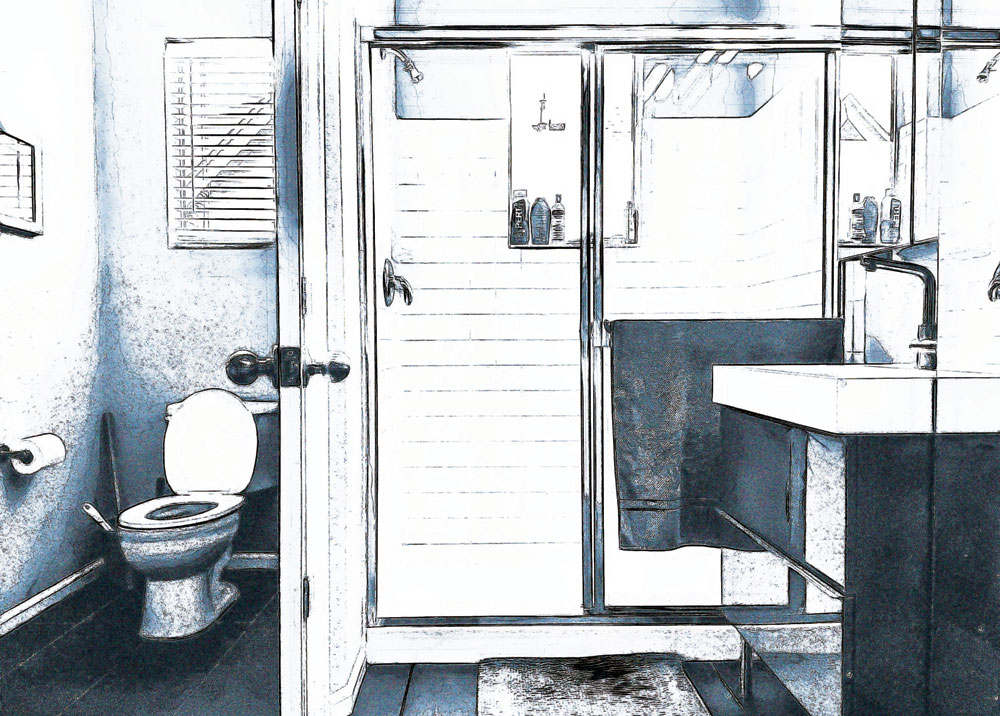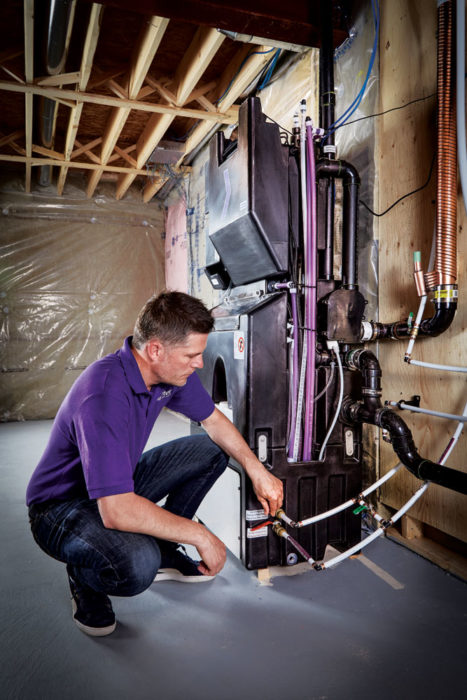
Front Porch photo/illustration by Steve Larson.
“Why do we flush our toilets with perfectly good drinking water? It doesn’t make any sense,” says John Bell, Chief Commercial Officer of Greyter Water Systems. Over the next 18-24 months, Greyter will be installing greywater recycling appliances in 40 new homes being built in Central Park by Lennar Homes.
“I think we’d all agree that water’s a precious resource. In Colorado, maybe even more precious, considering the importance of the Colorado River in seven states and the nearly 40 million people needing that water. If you can get a second use out of it for toilet flushing, it just seems like an absolute no-brainer.”

Greywater systems in new homes are built to collect and recycle water from the shower, bath, and sink. The appliance, typically located in the basement, is about the size of a stacked washer and dryer. It provides more than enough water for daily toilet flushing. Photo of John Bell, co-founder of Greyter Water Systems, is courtesy of Greyter.
Bell provides water usage calculations that show showers and baths will provide all the greywater needed to meet the daily demand of toilet-flushing: A shower uses two gallons per minute, so two 10-minute showers would use 40 gallons. Toilets today use 1.28 gallons per flush, so daily toilet-flushing for a family of four uses about 25 gallons if each person flushes five times a day. A greywater appliance would save a family of four about 9,000 gallons annually.
An added benefit of the Greyter system is it detects toilet leaks. “If it’s a slow leak, you may never know that the toilet flapper isn’t sitting right or the fill valve is slightly open,” Bell adds.
The quality of recycled greywater—typically water drained from bathroom sinks and showers—must meet certain standards.*
Bell says the standard for evaluating reused water quality (NSF350) produces greywater to a near-potable level. “All greywater systems need multiple stages of filtration for disinfection, which is nearly impossible to do in a small system because you need to hold a volume of water. We spent about five years trying to optimize the size based on holding capacity and the way we filter and treat water.” The Greyter system is about the size of a stacked washer and dryer.
Receiving NSF 350 certification “requires 26 weeks of continuous testing with regularly scheduled sampling throughout, typically three days a week,” according to NSF’s website (bit.ly/35FywrN). “It’s a pretty nasty cocktail,” Bell says, “that includes shampoo, toothpaste, conditioner and soap dosed into your system every day; you have to treat and process that water daily, then you’re tested on the water quality that has to meet a specific target, with no user maintenance.”
The base price of Greyter’s appliance ranges from $4,500 to $5,000, depending on the exact home installation. This solution is ideal for large-scale, new construction, but retrofitting is “almost cost prohibitive, unless you’re doing a major renovation,” says Bell. “[In an older home] you’re not going to open up walls and ceilings, re-tile and re-drywall to deal with the challenges of isolating that greywater. If you were trying to retrofit a three-story house, trying to capture a master bedroom on the third floor and get that water down to the basement, for sure, it wouldn’t make sense.”
About half of single-family residential water use is outdoors, and a hot, dry year can mean customers use more water than usual, according to Denver Water (bit.ly/2TSoLDN). Recycled water can contribute significant savings of fresh water, and that savings is reflected on your monthly water bill.
“We see the Lennar Homes project [with a model home at 5668 Dallas St.] providing some leadership in this arena,” said CEO Mark Sales. “If we can manage water more efficiently within the home and create more water-efficient communities, that’s where we think we get the win for everybody. Ultimately we believe it’s just a matter of time before you see a considerable percentage of new building incorporate greywater recycling as a common appliance within the household.”
* In Colorado, Regulation 86 (bit.ly/3wKNEjB) establishes the criteria for local municipalities. Nationally, NSF 350 standards, included in Regulation 86, must be met.




0 Comments